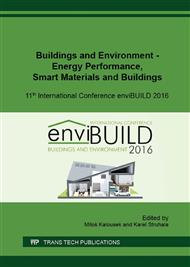p.3
p.11
p.19
p.24
p.32
p.40
p.48
p.56
Development and Experimental Verification of Sliding Elements of Transparent Loggia Enclosures in High-Rise Building
Abstract:
Originally open balconies and loggias of high-rise residential building showed a significant aerodynamic load - discomfort for users. Subject of the contract cooperation with the investor was therefore development, experimental verification and optimization of the strength and functional parameters of sliding elements of transparent loggia enclosures from the effect of the dynamically changing wind pressure (pressure - suction), as well as the elimination of undesirable acoustic expressions. This paper introduces the aerodynamic study of the building with the objective of quantifying the maximum load on sliding elements from the effects of wind as the boundary condition for their dimensioning. It describes the final design of transparent sliding elements and their experimental verification in a large pressure chamber in laboratory. The elimination of undesirable acoustic expressions was successfully implemented through design optimization with use of acoustic camera.
Info:
Periodical:
Pages:
3-10
Citation:
Online since:
December 2016
Authors:
Price:
Сopyright:
© 2017 Trans Tech Publications Ltd. All Rights Reserved
Share:
Citation:


